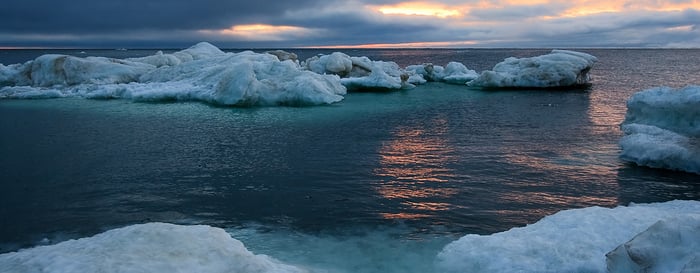The team spotted a humpback whale ahead of us, but this time the large tail lob that the whale treated us to told us he wasn’t in the mood for any close encounters. Immediately Andrews signaled the captain to shut down the engines while she dropped her hydrophone into the water. Donning headphones she listened intently to the sounds of the ocean. She smiled and said: “There’s our singer,” whilst pressing record on her handheld device.
“All of the males at each breeding ground sing the same song, yet every year the song is different,” said Andrews. “Male humpback whales sing a complex, culturally transmitted song, for mate selection, but research suggests that singing males also attract other males. In this way, the song is learned and transmitted across the entire Pacific Ocean basin, originating on the east coast of Australia and moving eastward over time.” Scientists use these songs to calculate where whales are coming from and identify different breeding locations — important information when determining how to better conserve this species.
Andrews passes the headphones around the team. It is impossible not to smile when you see everyone’s reactions to hearing whale songs performed in real time. The haunting underwater soundtrack is utterly compelling and overwhelmingly beautiful.

Over the next few days we find mothers with first year calves. This is a sensitive time, so we keep our distance. I launch our drone to unobtrusively observe them from the air. From a birds-eye perspective we can observe their behaviour and gauge the size and health of the individual animals. When I was filming one particular calf, I noticed that while it stayed within a fin’s reach of its mother it seemed delightfully unaware of the drone I was using to capture footage for the team. As the drone drew nearer the calf lazily rolled over and sunned itself on its back.
While we were able to use the drones to survey the animals' behaviour, it was proving more difficult to deploy satellite tags on the animals, which would provide valuable data for the team so they could see which route the mammals took on their 7,000 kilometre journey to Antarctica.
Jake Levenson, a marine biologist from the US Department of Interior who is a satellite tagging specialist for Conservation International, was having difficulty tagging these elusive creatures. We needed to get close to them to be able to deploy a tag, but the exposed seas and the elusive whales meant that this task was nigh on impossible. The closest attempt resulted in missing the whale and a USD$2,200 tag sinking into the depths of the ocean.
However, the audio and visual we did record, meant that we could add individual tail fluke IDs to the growing Niuean catalogue of whales. Providing effective conservation is crucial to ensuring these highly intelligent giants of the sea endure. This work contributes to the design and management of Niue's large scale marine protected area and National Whale Sanctuary. We hope to return soon to the crystal clear waters of Niue and continue the research on these incredible creatures.
Follow Richard Sidey at @richardsidey
Arctic Wildlife Safari
- Search for polar bears hunting seals in the pack ice on an arctic safari
- Explore historical sites including early whaling camps, trappers’ cabins, deserted coal mining operations, and an abandoned polar research station
- Sea kayaking near tidewater glaciers and icebergs
- Look out for humpback whales from the outdoor decks
- Take advantage of the included photography program and learn alongside the onboard expert
Brazil’s Wonderful Wildlife and Waterfalls
Iguazu Falls Pantanal Rio de Janeiro São Paulo Brazil South America
-
Explore the colonial heart and modern art scene of Sao Paulo
-
Witness the power of the mighty Iguazu Falls
-
Discover the flora, fauna and birdlife of the Pantanal
-
See panoramic views of Rio de Janeiro from Corcovado and Sugarloaf Mountain
-
Relax on Ipanema Beach before exploring Rio’s thriving nightlife
Southern Malawi Adventure
-
Snorkel amongst vibrant cichlid fish in Lake Malawi
-
Experience life on a tea and coffee estate in Thyolo
-
Witness rare wildlife in their natural habitat at Liwonde
-
Engage with local Malawian communities
-
Relax on the tropical island paradise of Mumbo Island









